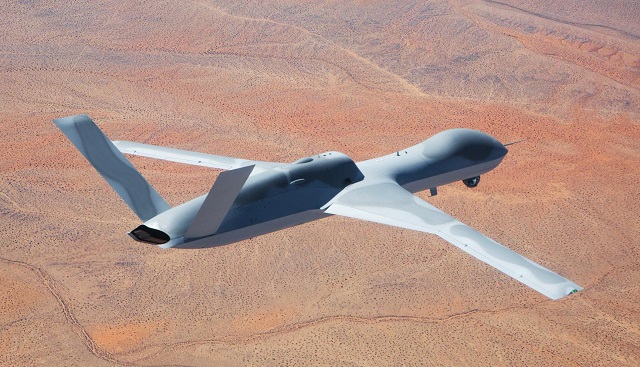On 27 October, General Atomics Aeronautical Systems completed the first flight of an extended-range Predator C Avenger, which features wings extended by 3.2m to 23.2m (76ft).
The extended-range variant of the jet-powered Avenger has kept its 13.4m (44ft)-long fuselage and 1,360kg (3,000lb) payload bay, but General Atomics also added some 1,000kg of fuel, extending the platform’s endurance from 15h to 20h.
Both the legacy Avenger and the Predator B – operated by the US Air Force as the MQ-9 Reaper – have a 66ft wingspan. Last February, General Atomics demonstrated an extended-range Reaper retrofitted with 20m wings and additional hard points. The improved wings help increase the Reaper’s endurance from 27h to 40h and also feature leading edge de-ice provisions. The USAF operates a retrofitted version of an extended range Reaper, which features two wing-mounted fuel tanks.

An older version of the Avenger
General Atomics Aeronautical Systems
Avenger’s centreline Pratt & Whitney Canada PW545B turbofan engine helps push the platform to 400kt, outperforming the Honeywell TPE331 turboprop-powered Reaper, which flies at a maximum speed of 240kt. But while Avenger outperforms with speed, it is limited in endurance. The longer wings help compensate for the aircraft’s lower endurance, but even the legacy Reaper’s 27h endurance dwarfs the 20h advertised on the extended version of the Avenger.
Although the Avenger has completed more than 13,000 flight hours, no US service has acknowledged the aircraft as a programme of record.
General Atomics developed the armed reconnaissance platform with internal research and development funds and demonstrated the first flight in 2009. The USAF has purchased one Avenger as a technology demonstrator, and it is believed the Central Intelligence Agency (CIA) operates the aircraft as well.
Meanwhile, the company is investing funds into the power, thermal management, beam control and beam director for a high energy laser weapon compatible with the Avenger. The company could begin integrating the laser package onto the platform by 2017.
Source: FlightGlobal.com


























